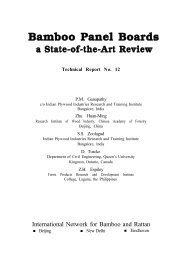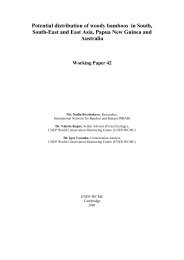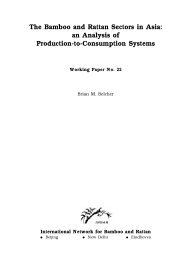ISSN ………… - International Network for Bamboo and Rattan
ISSN ………… - International Network for Bamboo and Rattan
ISSN ………… - International Network for Bamboo and Rattan
Create successful ePaper yourself
Turn your PDF publications into a flip-book with our unique Google optimized e-Paper software.
those made from bamboo attacked by stain fungi; which in turn were slightly lower than those made<br />
from healthy bamboo (Guha et al. 1958 547 ; Guha 1960 152 ; Bakshi et al. 1960) 539 . It is not advisable<br />
to store bamboos <strong>for</strong> long periods in warm <strong>and</strong> humid areas or under conditions favourable <strong>for</strong> decay.<br />
However, if bamboos have to be stored <strong>for</strong> long periods, storage should be under water or with<br />
suitable prophylactic treatment (which should not interfere with pulping) to prevent decay.<br />
Different studies have been reported on flowered bamboo (Bhargava 1945 136 ; Bakshi et al. 1968 540 ;<br />
Kala 1973 221 ; Dhoundiyal et al. 1973) 144 . Flowered bamboo culms are more resistant to beetle<br />
attack, may be due to starch depletion. Flowered bamboo, if in sound condition, is equally good <strong>for</strong><br />
pulping <strong>and</strong> bleaching.<br />
When Bambusa polymorpha <strong>and</strong> Cephalostachyum pergracile were stored <strong>for</strong> 12 months in piles in<br />
the open or submerged in a natural pond, deterioration through stain <strong>and</strong> rot fungi was severe in the<br />
piles kept in the open but negligible in the bamboo kept under water. Neither duration nor method of<br />
storage had a great effect on chemical composition <strong>and</strong> sulphate pulp yields, but some strength<br />
properties of the pulp decreased about equally in both methods during storage. Brightness <strong>and</strong><br />
response to bleaching were better in pulp from water-stored bamboo; this was also confirmed in a<br />
limited bleaching trial on mechanical pulp from B. polymorpha (Mai-Aung et al. 1969) 557 .<br />
Purushotham (1970) 561 suggested measures <strong>for</strong> protection of bamboo against fungal <strong>and</strong> insect attack<br />
at felling <strong>and</strong> stacking sites. Prophylactic treatment of the raw material while storing outdoors reduced<br />
the wood substance loss by 28-30 per cent <strong>and</strong> pulp yield loss by about 30 per cent (Guha <strong>and</strong><br />
Ch<strong>and</strong>ra 1979) 542 . Kumar et al. (1980) 555 reviewed the work done on storage losses <strong>and</strong> the adverse<br />
effect of inadequate protection on strength of paper sheets, bleach consumption <strong>and</strong> brightness <strong>and</strong><br />
loss in digester capacity utilization. Possible ways of using effective chemicals <strong>for</strong> overcoming these<br />
problems were also described.<br />
For long-term storage of bamboos in the open, it is recommended that the stacks are put-up on<br />
specially prepared ground (above a 10 cm layer of boiler ash <strong>and</strong> powdered lime sludge containing<br />
about 2% BHC) to prevent termite attack. The stacks should be profusely treated during different<br />
stages of stack <strong>for</strong>ming <strong>and</strong> may be covered with treated bamboo mats or thatched grass (Kumar et al.<br />
1994) 554 . Treatments must be done in such a way that chemical pollution of the environment is<br />
avoided. Stacking methods <strong>and</strong> treatments depend on the incidences of both fungal <strong>and</strong> insect attack.<br />
For reed bamboos, vertical stacking results in a small gain in pulp yield over horizontal stacking<br />
because the <strong>for</strong>mer suffers less fungal damage. Monthly treatment with borax – boric acid results in a<br />
substantial gain (Gnanaharan et al. 1982) 560 . A pest management strategy using minimal application<br />
of pesticide is recommended by Nair et al. (1983) 560 .<br />
35












